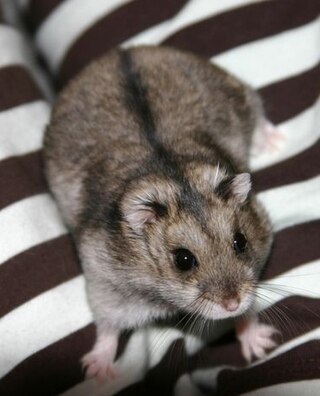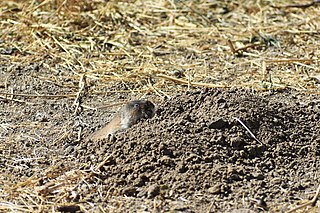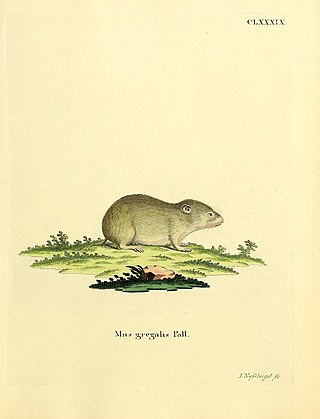
Hamsters are rodents belonging to the subfamily Cricetinae, which contains 19 species classified in seven genera. They have become established as popular small pets. The best-known species of hamster is the golden or Syrian hamster, which is the type most commonly kept as pets. Other hamster species commonly kept as pets are the three species of dwarf hamster, Campbell's dwarf hamster, the winter white dwarf hamster and the Roborovski hamster.

Campbell's dwarf hamster is a species of hamster in the genus Phodopus. It was given its common name by Oldfield Thomas in honor of Charles William Campbell, who collected the first specimen in Mongolia on July 1, 1902. It is distinguished from the closely related Djungarian hamster as it has smaller ears and no dark fur on its crown. Campbell's dwarf hamster typically has a narrow dorsal stripe compared to the Djungarian hamster and grey fur on the stomach. This hamster may be raised in captivity and kept as a small pet.

Phodopus, a genus of rodents in the hamster subfamily Cricetinae—a division of the larger family Cricetidae—is a lineage of small hamsters native to central Asia that display unusual adaptations to extreme temperatures. They are the only known hamsters that live in groups and, in some cases, rely on significant contributions by males to the raising of offspring. They are nocturnal and active throughout the year; they do not hibernate. Species of Phodopus, together with members of the genera Cricetulus, Allocricetulus and Tscherskia are called dwarf hamsters because of their small size relative to other hamsters.

Cricetulus is a genus of rodent in the family Cricetidae ; it has seven member species that inhabit arid or semi-arid regions in Eurasia.

The Chinese striped hamster, also known as the striped dwarf hamster, is a species of hamster. It is distributed across Northern Asia, from southern Siberia through Mongolia and northeastern China to northern North Korea. An adult Chinese striped hamster weighs 20 to 35 g, and has a body length of 72 to 116 mm with a tail of 15 to 26 mm. It is smaller and has a much shorter tail than the greater long-tailed hamster, Tscherskia triton, which inhabits much of the same range.
The Tibetan dwarf hamster is a species of rodent in the family Cricetidae. It is found not only in Tibet and China, but also in India and Nepal in mountainous regions at altitudes of up to about 5,200 m (17,100 ft).
The Kam dwarf hamster is a species of rodent in the family Cricetidae. It is found only in the mountains of western China where it inhabits grassland, shrubby marshes and steppes. Although it has a limited range, the International Union for Conservation of Nature has assessed its conservation status as being of "least concern".

The grey dwarf hamster, grey hamster or migratory hamster is a species of rodent in the family Cricetidae. Its range extends from Eastern Europe through the Middle East, Russia and Central Asia to Mongolia and western China. The grey dwarf hamster has grey fur and a head-body length ranging from 85 to 120 mm. The International Union for Conservation of Nature has assessed its conservation status as being of "least concern".
Sokolov's dwarf hamster is a species of rodent in the hamster and vole family Cricetidae. Previously listed as conspecific with Chinese striped hamster, it has been listed as a separate species since 1988. It has a distinctive dark stripe down its back on and otherwise grey body. It is found in China and Mongolia, and lives in burrows beneath desert shrubs.

The Zaisan mole vole, or eastern mole vole, is a species of rodent in the family Cricetidae. It is found in central Asia.

The Libyan jird is a species of rodent in the family Muridae. It is found in Mauritania, Morocco, Algeria, Tunisia, Libya, Egypt, Jordan, Syria, Saudi Arabia, Iran, Iraq, Afghanistan, Turkmenistan, Uzbekistan, Kazakhstan and Western China. Its natural habitats are subtropical or tropical dry shrubland, intermittent saline lakes, hot deserts, and rural gardens.

The narrow-headed vole is a species of rodent in the family Cricetidae. Ranging over northern and central Asia and also into Alaska, it is the only species in the subgenus Stenocranius.
Maximowicz's vole is a species of rodent in the family Cricetidae. It is found in northeastern China, Mongolia, and eastern Russia.
The Guinean gerbil is a species of rodent found in Burkina Faso, Gambia, Ghana, Guinea, Guinea-Bissau, Ivory Coast, Mali, Senegal, Sierra Leone, and possibly Liberia. Its natural habitats are subtropical or tropical dry forests, dry savanna, rocky areas and arable land, but it is mostly found in areas laterite or clay soils, and with variable amounts of vegetation and dense scrub. This species is described as common and has a stable population and a wide distribution, so the International Union for Conservation of Nature has rated its conservation status as being of "least concern".
The Balikun jerboa is a species of rodent in the family Dipodidae. It is found in arid areas of northwestern China and Mongolia. It eats green plants, plant roots, seeds, grasshoppers and beetles.

The northern three-toed jerboa is a species of rodent in the family Dipodidae. It is the only extant species within the genus Dipus. It ranges across Iran, Uzbekistan, Turkmenistan, Kazakhstan, Russia, China and Mongolia. A common species, the International Union for Conservation of Nature rates it as being of "least concern".

The long-tailed forest shrew, or long-tailed mouse shrew, is a species of mammal in the family Soricidae. It is endemic to South Africa, where its natural habitats are Mediterranean-type shrubby vegetation and swamps.
The Lama dwarf hamster is a species of rodent in the family Cricetidae. It is found only in the mountains of western China where it inhabits grassland, shrubby marshes and steppes. Although it has a limited range, the International Union for Conservation of Nature has assessed its conservation status as being of "least concern".
The Ikh Nartiin Chuluu Nature Reserve, commonly shortened to Ikh Nart Nature Reserve is a protected area in the East Gobi Province of Mongolia. It occupies part of two counties, Dalanjargalan and Airag. The nature reserve has an area of about 66,000 hectares and was established in 1996. It consists of rocky outcrops surrounded by dry grassland and semi-desert steppe and is one of the places in which the rare argali wild sheep can be found.











